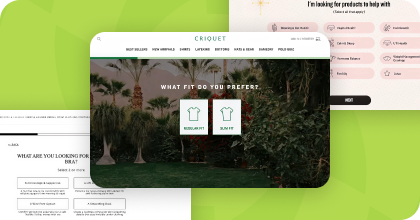May 9, 2023
Don't just implement a reactionary abandonment strategy—build a preventative one! Anticipate your customers' needs and build trust with them before abandonment happens.


Steal High-Converting Ideas From Leading DTC Brands
Browse 50+ real examples of personalized marketing funnels you can replicate today.
Last month, we released a resource to help you prevent cart abandonment.
Writing that piece got me thinking… abandonment is often a symptom of a greater problem. And like most problems, too often we work to solve it when it happens instead of preventing it in the first place. In other words: we spend our time pulling the weeds when we could apply a weedkiller to prevent them from growing at all.
So, how do you kill off cart abandonment before it grows?
Whether they balk at the price, are skeptical the product will work, or simply got distracted, cart abandonment often begins with a lack of trust. If they bonded with your brand, believed your claims, and were sure you were the best solution for their problem, it’s unlikely they’d disappear halfway through the buying process. So, how can you cultivate trust as a brand?
By building a relationship with your customers before they begin to fill their cart and check out, you prevent the abandonment obstacle. Let’s break this down into 2 parts:
In 2022, 5 million new businesses were started. That’s 42% higher than pre-pandemic levels! Between new and existing businesses, social media platforms are increasingly crowded with ads from companies trying to sell products.
With so many new products and services, it makes sense that a consumer’s default response includes some healthy suspicion. Your challenge is to prove that you are a reputable, trustworthy company that can solve their problem. How? Let’s take a look.
Does this sound like you?
What to do instead:
Practical steps to take on your site:

Consumers make purchasing decisions based on whether something seems “worth it.” When given the choice between a fresh, organic dinner for $35 and a highly processed, drive-thru dinner for $12, the health conscious will choose the former every time. The two meals accomplish the same objective: to eat dinner. But the organic meal is more valuable to this customer and therefore worth the price.
You may be experiencing cart abandonment because the customer was never quite convinced that your price was worth it. Maybe they found someone who sells something similar for less. Maybe no one sells what you do exactly, and that makes them wonder if your product or service will work. Whatever the reason, it’s up to you to prove your value.
Does this sound like you?
What to do instead:
Practical steps to take on your site:

There are many strategies out there to help you prevent cart abandonment as it’s happening. Once the cart is full and the customer is walking away. But there is so much more to avoiding cart abandonment! Creating a relationship and personalized experience with your customers from the start is the best way to build a bond. Customers who have bonded with a brand become loyal returning customers. Loyal customers don’t abandon carts and come back to spend again.

Start using widgets to personalize your user experience today! Here are a few more resources to get started:
Zero consumption based pricing with zero limits allows your brand to deploy Digioh across your entire marketing funnel.
book a demo
